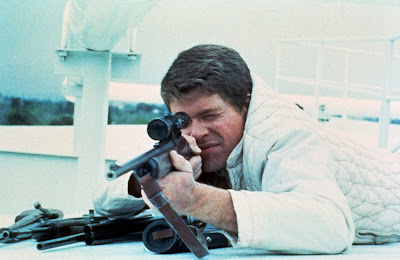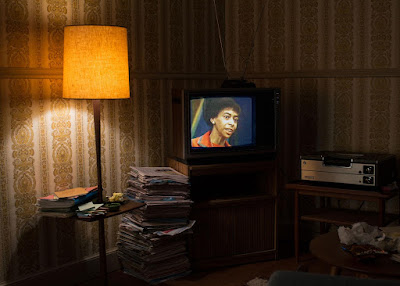Monday, 28 February 2022
Balls of steel: "Jackass Forever"
Saturday, 26 February 2022
For what it's worth...
My top five:
1. Annette
1. The Apartment (Saturday, BBC2, 1pm)
Friday, 18 February 2022
For what it's worth...
My top five:
1. Annette
1. Notting Hill [above] (Saturday, ITV, 10.40pm)
Thursday, 17 February 2022
In memoriam: Douglas Trumbull (Telegraph 16/02/22)
Movie magic was a
Trumbull family business. His father Donald had been a technician in Hollywood’s
Golden Age, rigging the flying monkeys on The Wizard of Oz (1939); in
his later years, Trumbull Sr. won two technical Oscars for his innovations in
the fields of matte photography and motion-control camera systems.
His son landed his big
break assisting on To the Moon and Beyond (1964), a 15-minute short produced
by Graphic Films for the World’s Fair that zoomed out from a sub-atomic view to
observe the Earth from space. Among its admirers was Stanley Kubrick, who flew
Trumbull to London, initially to provide animations for 2001’s computer
monitors.
Quick to earn his
famously circumspect employer’s trust, Trumbull assumed additional
responsibilities as production wore on: “He would say, ‘What do you need?’ and
I’d say, ‘Well, I need to go into town and buy some weird bearings and some
stuff’ and he would send me off in his Bentley, with a driver, into London. It
was great!”
It was a new frontier, in
every sense: as Trumbull put it, “We wanted the audience to feel like they were
actually going into space.” Yet creative freedoms were tempered by Kubrickian
control; the two men fell out after the director assumed sole onscreen credit
for the film’s Oscar-winning effects, with Trumbull vowing to work independently
in future.
His freelance career
began inauspiciously. Trumbull underbid for the effects work on Universal’s The
Andromeda Strain (1971), leaving him with only $250,000 to generate the microscope-like
close-ups of the titular virus. A distribution quirk saw that film jettisoned
on an underpromoted double-bill with Trumbull’s directorial debut Silent
Running (1972), an unusually emotive, eco-themed sci-fi about a lone
scientist (Bruce Dern) tending plantlife on a spaceship orbiting a dying Earth.
Completed for a tenth of 2001’s
budget, Silent Running allowed Trumbull to finesse a sequence involving
Saturn’s rings originally visualised for 2001, but elsewhere the modest
resources compelled him to improvise. College students – including future
effects whizz John Dykstra – were hired to suppress costs, many set to
assembling the 650 tank modelling kits used in the film’s miniature shots.
Though a commercial flop,
Silent Running proved hugely influential on those who saw it. George
Lucas approached Trumbull to work on Star Wars (1977); Trumbull turned
the offer down, while approving Lucas’s plan to model the droid R2-D2 on Silent
Running’s expressive drones Huey, Dewey and Louie. (Both Trumbull Sr. and
Dykstra would work on Star Wars in various capacities.)
By that point, Trumbull
was busy elsewhere, having been appointed VFX supervisor on Close Encounters of the Third Kind (1977). This was an especially demanding production, entailing
200 effects shots that needed to inspire awe while meshing with Steven
Spielberg’s completed live-action footage. Yet Trumbull found practical
solutions to the film’s challenges: the ominous cloudscapes signalling the
aliens’ arrival were formed by filling fish tanks with saltwater and paint. It earned
him a first Oscar nomination, losing – in a field of two – to Star Wars.
Visual effects ingenuity sometimes
resembles elevated child’s play, yet Trumbull’s experience on Star Trek: The
Motion Picture (1979) was hard labour. Belatedly hired after another
effects house failed to bring the U.S.S. Enterprise to cinematic life, Trumbull
worked overtime so the film could hit its planned Christmas release date; it landed
him a second Oscar nod, plus ten days in hospital with an ulcerated stomach.
Upon recovery, Trumbull
was lured back to hired-hand work on Ridley Scott’s Blade Runner (1982).
Drawn by the prospect of detailing a careworn Earth rather than something stratospheric,
he contributed several elements to the stunning opening panorama, including the
images projected onto skyscrapers and the refinery flames, recycled from
explosions Trumbull had filmed for Zabriskie Point (1970).
That worldbuilding was
again Oscar nominated, again unsuccessful, but by then he was directing once
more. Trumbull initially conceived the psychological thriller Brainstorm
(1983) as a showcase for a new, high-definition photography process known as
Showscan. When studio MGM balked at the cost, Trumbull ploughed on, only for
the project to be comprehensively derailed when star Natalie Wood drowned in
mysterious circumstances mid-shoot.
Studio bosses wanted to halt
production and claim the insurance, but Trumbull persevered, recruiting Wood’s
sister Lana as a stand-in for the remaining shots. That there was anything
releasable was some achievement, but reviews were middling and box-office tepid,
sending Trumbull into retreat: “I just had to stop. I had been a
writer-director all my life, and I decided it wasn’t for me because I was put
through a really challenging personal experience… I decided to leave the movie
business.”
Douglas Huntley Trumbull
was born in Los Angeles on April 8, 1942 to Donald Trumbull and Marcia Hunt, a
commercial artist. A tinkerer from an early age, young Douglas built
crystal-set radios and soaked up science-fiction movies; he studied
illustration at El Camino College with the aim of becoming an architect,
joining Graphic Films upon graduation, where he also worked on promotional
films for the Air Force and NASA.
In later life, Trumbull
moved to Massachusetts and into the less pressurised field of motion simulators
and theme park attractions, most prominently directing a short film for the Back to the Future ride at Universal Studios Florida, launched in 1991. He won a
technical Oscar in 1993, for his work in the development of a new 65mm camera,
and was appointed vice-chair of IMAX in the mid-1990s, as the corporation
expanded worldwide.
In 2011, he pulled the
old magic tricks out of retirement, photographing chemical reactions in petri
dishes and injecting paint into water tanks for the eyepopping Creation of the
Universe sequence in Terrence Malick’s The Tree of Life: “It was a
working environment that’s almost impossible to come by these days… Terry
wanted to create the opportunity for the unexpected to occur before the camera.”
He continued tinkering, going
viral in 2010 with a video that proposed a solution to the BP oil spill, and offering
his Magi Pod, an immersive boutique cinema, as a cure for the modern
multiplex’s projection ills. He won the Tesla Award in 2011, and an honorary
Oscar in 2012. Thereafter he was an avuncular presence on the convention
circuit, embracing fans beguiled by a groundbreaking legacy: “They reinforce
some enthusiasm about my work. It’s very hard to keep me going, because the
setbacks were really tragic and difficult.”
He is survived by his
third wife Julia Trumbull (née Hobart), and by Amy and Andromeda, two
daughters by his first wife Cherry Foster; his second wife, Ann Vidor, died in
2001.
Douglas Trumbull, born April 8 1942, died February 7 2022.
Tuesday, 15 February 2022
On demand: "Cow"
Friday, 11 February 2022
For what it's worth...
My top five:
1. Annette
1. The Conversation (Saturday, BBC2, 1am)
On demand: "Targets"
Monday, 7 February 2022
Drawing it out: "Flee"
Friday, 4 February 2022
For what it's worth...
My top five:
1. Annette
1. Collateral [above] (Saturday, ITV, 10.35pm)
My streaming gem: "Karnan" (Guardian 04/02/22)
The film's first half, however, serves chiefly to define its warrior-in-chief – and thus to demonstrate that appearances can prove deceptive. Karnan initially presents as a nice lad with sensible hair, ticking the first box of Indian movie heroism by being good to his put-upon mother (Janaki). Yet the characterisation is soon complicated. A drinker and a gambler, Karnan is less your typical masala maverick than a punk-in-waiting. He’s a hothead who spends this first hour getting into scraps, pushing away the one gal who’s crazy about him, and – in a pre-intermission sequence that must have been tremendous fun to shoot – singlehandedly trashing one of those rackety old buses pootling between backwaters. (He does much the same to a police station just after the break.)
This is a kid with fire in his belly – that’s what makes him such a hothead – yet while Selvaraj grasps these flames can be destructive, he also knows that in certain cases they’re exactly what’s required to effectuate real and lasting change. Sometimes, the movie posits, you have to burn down the whole rotten system and start again from scratch. The blazingly unpredictable hero is one reason Karnan emerges as such an unpredictable watch – it’s a morality play hitched to a genuine loose cannon. In the course of the film, Karnan will alienate family members and the wider village; at points, all we can cling to is the knowledge our boy seems unlikely ever to take the shit the penniless farmers around him have been forced to swallow for generations.
Somewhere in the mix, there’s a standard-issue crowdpleaser: you glimpse it whenever Dhanush raises himself up to his full 5’5” (5’4½”, when wet) and sets about righting this world’s wrongs – wealth inequality, police brutality – to what you suspect would have been huge cheers from the cheap seats had the film’s theatrical run not been curtailed by Covid. But it’s been overlaid by an artistry and delicacy rarely observed in films of this scale: if not the full Rajamouli, then not a hundred miles away. Cinematographer Theni Eswar provides lustrous cutaways to the region’s flora and fauna. And his overhead shots are positively sculptural: men gathering in a field mowed to resemble a bull, lovers trysting by a heart-shaped pond.
The worldbuilding is elevated to the point where it begins to resemble cosmology, yet as we look upon this busy, tempestuous, hotly contested few acres of land, we realise it’s not so far removed from our own backyards. It could do with more lady in its lake, true: where the Baahubalis offered equal-opportunity mythos, the women here fall between spectators and damsels-in-distress. (It’s a Dhanush film, and some hierarchies may be harder to topple than others.) Yet Selvaraj makes enough genuinely bold, even radical choices elsewhere, not least amid the tense siege finale, to make one regret that Karnan got shuttled off to streaming mid-pandemic. This is a film that takes up a small, everyday struggle, then rides hell-for-leather to fill the screen entire with it.











